Sony A200: Entry DSLR Roundup
by Wesley Fink on October 20, 2008 1:00 AM EST- Posted in
- Digital Camera
Field Notes
In our review of the Sony A350 we complained about the optical viewfinder just about as much as we praised the Live View tilt LCD. The Sony A100 had one of the better APS-C viewfinders, so the "tunnel-vision" A350/A300 viewfinder was quite a disappointment by comparison. It was clear Sony had to make compromises in the optical viewfinder to accommodate the Penta-Mirror shift and dedicated Live View sensor used in the A350/A300.
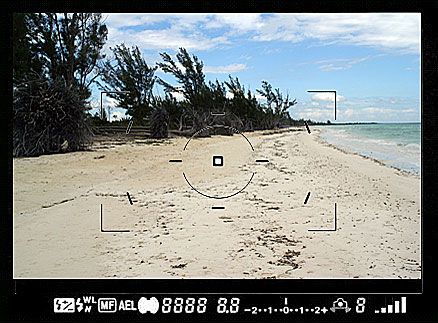
The A200 returns us to the big bright viewfinder of the A100. In fact, to our eyes the viewfinder appears unchanged from the A100 model, which is certainly a good thing. You also get a higher image magnification and a greater percentage of the total frame in the A200 viewfinder and on the LCD than you do on the A350/A300. This gives buyers a real choice. Traditionalists will prefer the A200 viewfinder, which is at least as good as anything in its class. Those who want a fast working Live View camera can choose the A350/A300, but users cannot get both a great optical viewfinder and great Live View in any current Sony camera.
Frankly, most of the competition's Live View implementations are slow as molasses and are not even close to the Sony A350/A300. However, they can be useful in non-action shooting situations or in the studio where the image magnification on the LCD can be very helpful for some critical focusing situations. Of course, who buys an entry DSLR for their studio? Today's Live View is more a checklist feature than a truly useful feature on entry cameras except the Sony A350/A300.
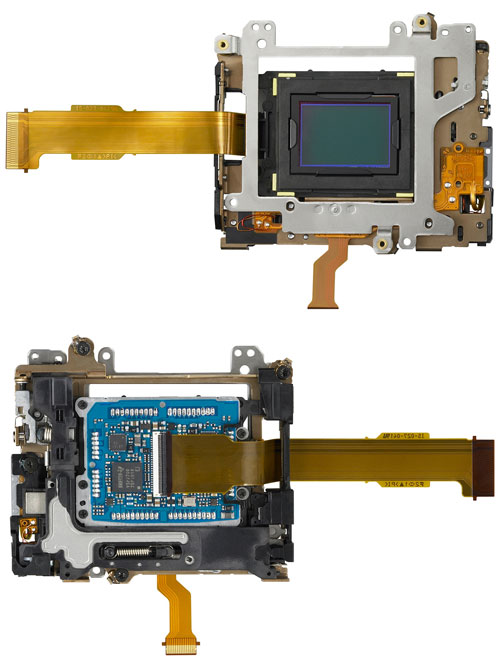
Image Stabilization and Auto Sensor-Cleaning Minolta was first with body-integral image stabilization and Sony has further refined a feature that most everyone but Canon and Nikon have adopted. It works very well on the A200 with up to 2 to 3 stops of added handheld capability. The Sony A200 IS works with any lens you can mount to the camera, and this includes current Sony lenses as well as millions of Minolta AF lenses that are often quite reasonable on the used market and on eBay. That same body IS also allows automatic sensor cleaning, which seemed to work well in under a wide variety of conditions. Our test cycle was just a few weeks but dust was never a problem with the A200 even though we used a wide variety of lenses in our testing.
Auto Focus In addition to more focus points and better focus tracking than many of their competitors, Sony claims the A200 Auto Focus is 1.7X faster than the A100. This is due to a higher torque motor and AF improvements borrowed from the newer A700. The AF module itself appears the same as the A100, but the AF speed in a side-by-side with the A100 found the A200 quite a bit faster in focusing. The A200 is not A700 fast, but the A700 is one of the fastest available in its class. However, compared to other entry models the A200 is one of the fastest focusing models.

Image Quality The Sony sensor is one of those components that promises more than expected if compared on price alone. The Sony 10.2MP CCD is a mature sensor that has been on the market for about two years. It is revised, refined, and coupled with a fast, recent Bionz processor in the A200. As a result, the A200 has a wider ISO range than others in the $499 price class. If you move up a notch to the $599 class the A200 still holds its own in image quality against any competitor. Image quality of the A200 is excellent, consistent, and dependable - which is a nice combination in an entry DSLR.
Controls The A200 is a model of simplicity in controls, but that should not be misread as lacking adjustment control. There is only one dial, where you select the all-auto mode, Program, Aperture-Priority, etc. and the Scene Modes.
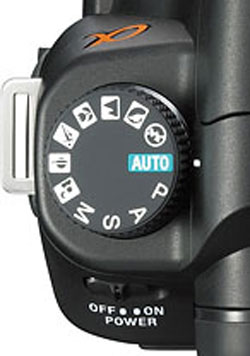
In Program mode there is a shift feature that is easy to use to control exposure. Turning the single front dial maintains the auto exposure but shifts the shutter speed (and corresponding aperture) to give more exposure choices. The single command dial is a concession to entry level, as was the single dial on the A100. The A700 has two dials with the front shifting shutter and the rear aperture in program shift. However, you can choose to have aperture instead of shutter as the shift parameter in the A200 menus.
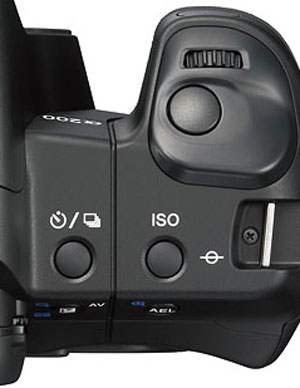
The top right features buttons for instant selection of ISO and Drive mode. The values are displayed on the rear LCD and can be adjusted with the joy-pad.
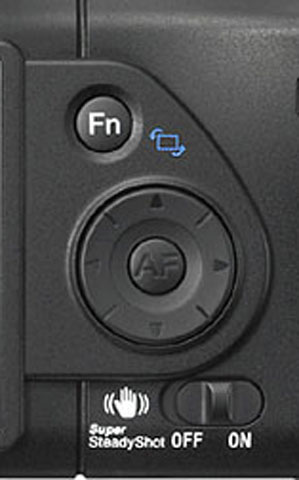
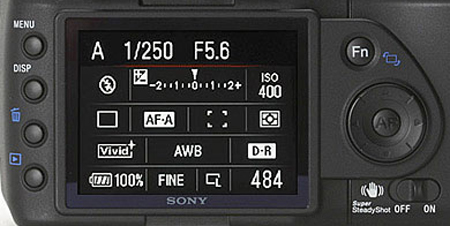
One of the nicest features of Sony DSLRs is the Fn button to the right of the LCD. This button brings up the Fn screen which allows adjustment of all the major parameters of the camera in one convenient place. Recent models from other manufacturers are featuring a similar feature, with the Canon 50D the most notable convert to the menu-less one screen adjustment summary.
DRO (Dynamic Range Optimizer) The Sony A200 is not a stripped entry model as many of its competitors are. The best example of this is the fact that Sony includes their DRO feature in the A200, which allows dynamic range expansion in captured images. It is even adjustable in the A200. This is certainly not a feature you would normally expect to find in an entry DSLR.
Ease of Use Sony has earned a deserved reputation in the DSLR market for simplicity or ease-of-use. We suspect this is more the result of the influence of Minolta engineers than Sony designers since the Sony point-and-shoots are often extremely complex and unintuitive. We do hope that Sony DSLR ease-of-use continues in the future.
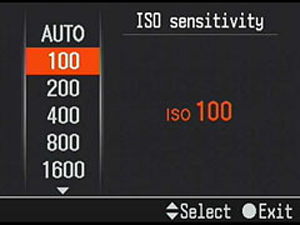
Auto ISO is another Sony feature that is very useful. In Auto ISO the camera selects the ISO to keep the exposure in a range that will likely produce sharp pictures. The Auto range is optimized and varies depending on the shooting mode selected or the Scene selection. Unlike some competitors, Sony has not really crippled the A200 or removed features to match a lower price point. All of the A100 features and options are continued or expanded in the A200 except for the Depth-of-Field preview button on the front, which was a victim of cost-cutting. But the ISO range is wider and the operation is even faster than the well-respected A100.
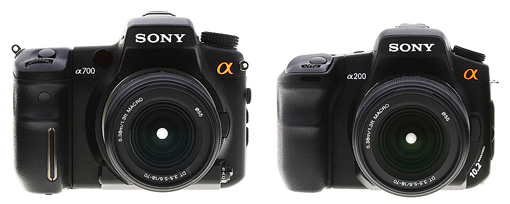
Handling The A200 is certainly smaller than the prosumer A700, but it is still larger than the similarly priced Nikon D60 and Canon XS entry models. Weight, however, is similar to these two competitors. Frankly, some have real issues with the small size of the D60 and Canon XS and prefer the Canon handling with the optional battery grip. Of course, the Nikon does not offer an optional battery grip so the D60 can't grow for better handling.
The A200 is a bit larger than the Canon and Nikon entry and fits larger hands better. If you find the XS/XSi and D60 too small for your liking, you will like the Sony A200 handling. Sony also makes an optional Battery Grip for the A200, and it is the same grip that fits the A300/A350. The A100 did not have a grip option.
Overall the ergonomics of the A200 seem to be right on target. It is easy to hold and operate and it is a further refinement of the A100 it replaces. If size is your main concern, however, the Canon, Nikon, and Olympus entry models are even smaller, though some complain they are too small for a DSLR and hamper ease-of-use.
Customization The A200 is one entry model that certainly does not look or behave like one. The only hints that this is not a midrange model are the lack of a depth-of-field preview button and just one command dial. However, features and options are otherwise what you would expect on a much more expensive camera. Bracketing control is present and not missing like the Nikon D60. Wireless flash control is present, unlike the Nikon D60 or the Canon XS, as is body image stabilization, unlike the Olympus E420.
As already pointed out Live View is not an A200 feature. If that matters to you move up to the A300 at $599. The A300 uses the same sensor as the A200 and features a real fast focus tilt LCS for Live View. If the real usefulness of the Live View is not so important you could select one of the A200 competitors in the entry class, all of which feature slow Live View as a feature for sometimes use.










32 Comments
View All Comments
Wesley Fink - Tuesday, October 21, 2008 - link
Those coming from P&S who insist on Live View would probably be happiest with the Sony A300 ($599 kit) or A350 ($799). If they want a fast-focusing capable traditional DSLR the A200 has a fast 9-point module that works well with off-center targets, tracks moving subjects well in sports and kid shooting, and is one of the fastest AF and largest brightest viewfinders in its class.When the new Panasonic G1 micro 4/3 hits the shelves it features a sensor with truly fast contrast-detect AF that many users will find very satisfying in Live View mode. It is the first contrast Live View we have seen that is likely to satisfy DSLR fans. It is likely the first of a new generation of fast Live View sensors that will be used in future competing DSLR cameras.
Heidfirst - Tuesday, October 21, 2008 - link
the wireless flash controller will also work with Sigma, Vivitar etc. flash guns too so you can certainly get down to at least 1/2 the price of a 42AM. I agree that it's probably a function not used y the majority of A200 users but some people who may might use the A200 as a 2nd/backup body to e.g. an A700.The A200 doesn't have live view & other than the A300/A350 with their particular & unusual implementation autofocus in live view is pretty poor (slow) on DSLRs. At any rate A200 autofocus is as good as (or better than) any other DSLR in it's price bracket.
remember that most p+s use contrast detect AF whereas DSLRs use phase detect (other than in live view except A300/A350).
computerfarmer - Monday, October 20, 2008 - link
I have noticed the Sony a200 review on dpreview dated July 2008 with an announcement date of January 2008. you can view it here.http://www.dpreview.com/reviews/specs/Sony/">http://www.dpreview.com/reviews/specs/Sony/
Perhaps there are changes I am unaware of.
This does appear to be a nice camera for the money. It has a good size sensor along with a decent kit lens.
Is it true the future is in cmos sensors?
What is the expected life span of CCD/CMOS sensors?
Wesley Fink - Monday, October 20, 2008 - link
CMOS sensors are cheaper to manufacture and it is much easier to integrate associated electronics into a CMOS sensor.It is worth mentioning, however, that the newest highest-res mid-size Kodak sensor, used in the new Leica Medium Format camera, is a CCD sensor, and some still claim the CCD to be superior in image quality.
For a more in-depth discussion of CCD vs. CMOS you may want to look back at our Digital Sensor Articles with Part 1 at http://www.anandtech.com/digitalcameras/showdoc.as...">http://www.anandtech.com/digitalcameras/showdoc.as... and part 2 at http://www.anandtech.com/digitalcameras/showdoc.as...">http://www.anandtech.com/digitalcameras/showdoc.as....
computerfarmer - Tuesday, October 21, 2008 - link
Thank you for your prompt reply.I took the time to read both the articles. They help in understanding the differences between CMOS/CCD sensors. Yet everything electronic has an expected lifespan. Does anyone have an expected lifespan for these sensors?
Hulk - Monday, October 20, 2008 - link
Looks to me like the lenses you are using are scratching the limits of the sensors, thus the results are all pretty much the same. Using a prime at f/8 will pretty much take the glass out of the comparison as most any prime is quite sharp at f/8 unless there is something wrong with it.Also please test using a subject with more colors so we can see how each camera handles demosiacing under increasing ISO.
Thanks for you hard work.
- Mark
Wesley Fink - Monday, October 20, 2008 - link
As stated on the test pages all the test shots used a 50mm f1.4 prime stopped down to f/4.0. We are down 3 stops from the rated speed and in all cases the glass is in its highest resolution range.The only exception to this is the Olympus tests, where we use a 35mm prime macro lens stopped down to f4, which has been tested to be in the highest resolution area of that lens.
This is because of the 2x factor on Olympus which gives us a 70mm equivalent. That is much closer to the 75- 80mm equivalent of the 50mm on the 1.5X-1.6X sensors. The 50mm macro on the Olympus would be equivalent to 100mm.
Test results are closer because other manufacturers have made dramatic improvements in their sensors in the last couple of years. Canon no longer enjoys the massive lead in sensor resolution and low noise they enjoyed with their CMOS sensors in the early years of DSLR technology. As pointed out in the test comments, many of today's competing cameras in the entry category use the Sony 10.2 megapixel sensor so results would be similar.
The biggest differences are detailed on page 9 in the comparisons of the 3 Sony sensors used in the A200, A350, and A700. The new 24.6 megapixel A900 could have been included as we have one in house, but it seemed a stretch to include a $3000 camera with resolution more than twice the entry-level DSLRs.
As Jarred has pointed out we always use the kit lens for sample images that are normally included in our reviews, so photos will be representative of what a normal buyer might expect. We similarly always use primes stopped down to the same f/4 for our noise and resolution tests to remove glass variations from the equation.
Hulk - Thursday, October 23, 2008 - link
The reasoning to use primes is NOT to test lenses but to try to eliminate lenses as a variable during testing and atually see how the bodies perform. By using less than very good lenses it's hard to tell what is limiting performance, the lens or the body.Since you are not testing scenes with any depth of field just use the sharpest setting, which is f/8 for just about any lens. f/4 would be applicable to test bokeh for a depth of field shot.
Again I know it's easy to complain. But really I'll I'm saying is use primes and stop down to f/8 so we can isolate the camera body performance.
Thanks,
- Mark
strikeback03 - Thursday, October 23, 2008 - link
According to photozone.de, the center resolution of the 50 1.4 is essentially constant from f/2.8-f/5.6, and down a bit at f/8 (corners top out at f/5.6).http://www.photozone.de/canon-eos/159-canon-ef-50m...">http://www.photozone.de/canon-eos/159-c...mm-f14-u...
slrgear calls f/4 and f/5.6 essentially tied, with f/8 a little worse.
http://www.slrgear.com/reviews/showproduct.php/pro...">http://www.slrgear.com/reviews/showproduct.php/pro...
Both of these tests are on an 8MP sensor, and the center resolution numbers are pushing the boundary of that sensor, so larger differences might be revealed in tests with a higher resolution sensor. For the 10MP sensors though f/4 would seem to be a very valid choice.
melgross - Thursday, October 23, 2008 - link
You know that 50 1.4's are not very good, even stopped down a couple of stops.I would choose the Olympus 35mm macro for quality over the 50's. Try a 50 or 60mm macro instead. It's about as close as you're going to get to the 35mm macro in quality to even out the lens issue.